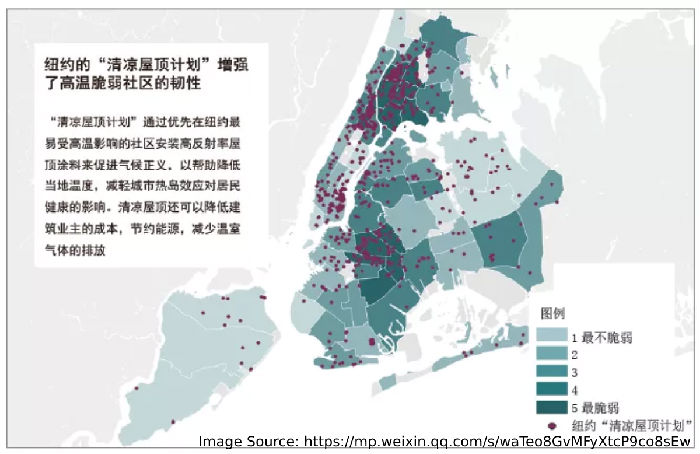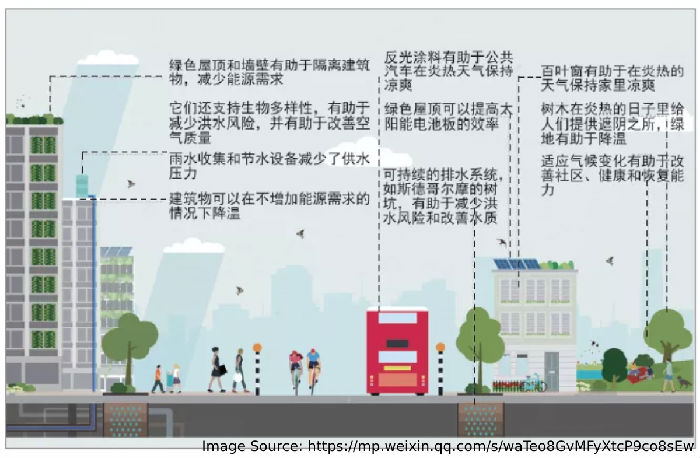


3.3 Planning technical tools
In foreign countries, innovative planning technologies have been proposed based on planning and development policies, including climate adaptation construction technologies and health promotion monitoring technologies, which combine hardware and software measures.
3.3.1 Climate adaptation construction technology
Innovative and scalable climate adaptation technologies include adaptive buildings, sustainable drainage facilities, and green roofs, which can effectively reduce the health risks caused by climate change.
(1) Adaptive architecture. Adaptive buildings can effectively mitigate the direct health risks caused by urban heat and flooding. New York focuses on constructing cool roofs, and specific measures include expanding roof shade and tree canopy coverage, and painting reflective materials on building roofs (Figure 6). London proposed a series of design solutions focusing on non-mechanical cooling of building exteriors and interiors to keep buildings cool. Specific measures include adjusting building layouts, planting deciduous trees on the south side of buildings, installing blinds and shades, encouraging greening of walls, laying high albedo materials on roofs, using materials with better insulation properties for building roofs and walls, and adjusting the size of building window openings (Figure 7). Rotterdam focuses on the design of buildings outside the embankment for flood protection. In addition to the overall elevation of the area outside the embankment to cope with flood risks, flood protection design measures for buildings and public spaces are proposed. For example, flood protection walls are installed in the local area. In addition, Rotterdam has accumulated proven experience in the construction of floating buildings. This makes the area outside the embankment more compatible with the water and allows city residents to live in the delta without compromising flood protection.

Figure 6: New York Cool Roofs Program Distribution Map

Figure 7 Illustration of adaptive building construction techniques in London
(2) Sustainable drainage facilities. Sustainable drainage facilities are an important planning technology to cope with the health risks caused by heavy rainfall and flooding. On the one hand, sustainable drainage facilities can effectively mitigate urban flooding; on the other hand, some sustainable drainage facilities, as a type of green infrastructure, can provide residents with places for daily recreation and physical exercise, thereby increasing their physical activity. The New York City Department of Environmental Protection has built over 4,000 green infrastructures, including rain gardens and encouraged the retrofitting of private land with rain gardens. London has turned gray areas on impermeable surfaces into urban green areas, reducing the rate at which rainwater enters the pipe drainage network by building rain gardens and planting street trees to address London's risk of heavy rainfall and flooding. Rotterdam widely used water plaza construction technology, water plaza can be used as a public square in the city to provide recreational and leisure places for the public, when the rainstorm can be used as a reservoir to collect and save rainwater, while creating a small pond landscape.
(3) Green Roofs. The construction of green roofs effectively utilizes the "corner space" of the city to increase the green area, which plays a vital role in increasing carbon sinks and mitigating the direct health risks caused by high temperatures, and part of the roof allows residents to enter, which can effectively promote physical activity, improve the health of residents and mitigate the indirect health risks caused by climate change. The roofs also play an essential role in promoting physical activity, improving residents' health and mitigating indirect health risks from climate change. London focuses on and promotes the development of community food growing, considering the use of rooftops and wall space for growing. In addition to the carbon sequestration and cooling effects of conventional green roofs, this will help promote more active lifestyles, good eating habits, and greater social integration and community cohesion, thereby improving community residents' physical and mental health. It also helps to reduce the cost of transporting food, thereby reducing transportation carbon emissions. Rotterdam promotes green roof projects in several ways, such as mandating green roofs on public buildings and new buildings, and encouraging green roofs on private homes through subsidy programs.
3.3.2 Health Promotion Monitoring Technologies
The development of science and technology has provided new ways for people to deal with health risks caused by climate change, including the use of big data and the Internet to monitor health risks and identify vulnerable people; and the use of big data to provide health and hygiene services for residents. New York provides comprehensive and specific information on public health services through the Health Services Map, and has introduced an app such as "Healthy New York" to assist residents in health monitoring and health recovery. London has introduced a free public climate justice mapping tool that highlights the communities with the highest levels of climate risk and helps residents decide what to do about it. Rotterdam uses smart tools such as sensor technology, decision support systems, and interactive knowledge tools in climate adaptation planning, and the Climate Adaptation Barometer is an effective smart monitoring tool used in climate adaptation planning in Rotterdam.
3.4 Implementation Strategies
In order to better implement and enforce legal policies and spatial plans to address climate change-related health risks, cities have adopted a series of specific local implementation tools, mainly in three areas: multi-stakeholder cooperation, education and awareness-raising, and attention to vulnerable groups.
(1) Multi-party cooperation. In terms of international, national, regional, and local collaboration, the New York government is committed to working with partners, business leaders, faith-based groups, public health groups, scientists, activists, and community citizens in other major U.S. cities (regional and state). The London government is committed to working with businesses to achieve the goal of a "zero carbon city" and has formed the London Climate Change Partnership, a network of experts from the public, private and community sectors, and is also working with the Health Improvement Board and local health care organizations and providing them with climate risk information and funding to improve their resilience to extreme weather. The Rotterdam government is committed to working with international/national businesses, local authorities, NGOs, academia, and public members, actively participating in organizations such as the Dutch Alliance for Sustainable Development and the C40 Cities Initiative Coalition, and integrating climate considerations into foreign policy.
(2) Public awareness and education. In terms of public education on health risks arising from climate change, the New York City Emergency Management Agency has launched a community emergency planning toolkit that provides guidance on how communities can reduce the negative impacts of these hazards, as well as an extreme heat awareness campaign that uses advertising to highlight the importance of heat safety warnings to seniors. London has increased residents' awareness of the health risks associated with climate change and their responses through events or festivals, such as the first London Climate Action Week and the London National Park City Festival. Rotterdam incorporates knowledge about climate and health and actions to take when faced with risks into the curricula of medical professionals, health researchers, city developers, and policy advisors, among others.
(3) Focus on vulnerable groups. In terms of attention to vulnerable populations, New York focuses on housing for vulnerable populations, and the study Protecting Seniors from the heat proposes a "new housing cooling program" for seniors. London promotes climate justice projects, supports and promotes inclusive design, and suggests that disadvantaged groups can easily enjoy the environment and services provided by the city. Rotterdam proposes a comprehensive transport network focusing on socially vulnerable areas. At the same time, the Climate Agenda states that the implementation of a national heat program will effectively avoid and reduce the impact of persistent heat on the health of vulnerable groups such as the elderly, the chronically ill and the overweight.
Source:<https://mp.weixin.qq.com/s/waTeo8GvMFyXtcP9co8sEw>
Translated by Chen Yan